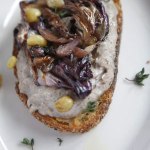 Here’s a yummy recipe posted today on Saveur. Crostini with Black-Eyed Peas, Radicchio, and Raisins.
Here’s a yummy recipe posted today on Saveur. Crostini with Black-Eyed Peas, Radicchio, and Raisins.
To help you understand how to take a recipe like this, to an off-the-charts nutrition level, here’s how.
INGREDIENTS
½ cup plus 2 tbsp. extra-virgin olive oil (first, cold pressed; organic)
1 tbsp. fresh thyme leaves
½ tsp. crushed red chile flakes
2 cloves garlic (1 finely chopped, 1 smashed)
1 bay leaf
1 15-oz. can black-eyed peas, 1 cup liquid reserved (soaked, sprouted, organic)
Kosher salt and freshly ground black pepper, to taste (replace Kosher salt with Celtic sea salt)
½ cup white wine
¼ cup golden raisins (unsulphured, organic, sun-dried)
1 head radicchio, sliced lengthwise into ½” wedges (organic or from a local farmer)
1 tbsp. sherry vinegar
8 slices crusty bread, such as ciabatta (naturally leavened)
The bread is the key here – making sure the flour has been properly prepared so that it is rendered as the most bio-available flour, meaning the flour was fermented/leavened properly to remove the anti-nutrient components that remain in all un-sprouted, unleavened, non-fermented breads and grains. Here’s an excerpt from the naturally leavened bread link above:
In the process of making sourdough bread, during the rising time (called proofing), bran in the flour is broken down, releasing nutrients into the dough. In particular, the phytic acid (phytin) in grain needs to be 90% neutralized in order for the minerals, concentrated in the bran, to be absorbed by the human body. According to the experiments done in Belgium, phytin can be neutralized by natural bacterial action and to a lesser extent, by baking. In naturally leavened bread, the combination eliminates all phytin, while in yeasted bread about 90% remains.
Enjoy this recipe, and cooking and preparing foods with the highest quality ingredients. And, by the way, it doesn’t have to be expensive!
Sharon, T H E E C C H E F
